Sept.7, 2024: Today’s work is finished. Thank you for your cooperation.
—–
Sept. 7, 2024: Switchover time of M365 has been revised due to a delay in the switchover process of faculty tenant. It is expected to be completed by 11:00 p.m.
—–
Sept. 7, 2024: Switchover time of M365 has been revised due to a delay in the switchover process. It is expected to be completed by 5:00 p.m.
—–
Sept. 5, 2024: Estimated time of swithchover for each system was added.
—–
The ICT will introduce an Integrated Authentication System (Single Sign-On) on Saturday, September 7, 2024 (preliminary date: September 8, 2024).
With the introduction of the Integrated Authentication System, each of the services listed below will be accessible without individual login operations using Sophia ICT Account ID/password.
In addition, the password reissue procedure will also be partially changed.
*What is Single Sign-On (SSO)?
Currently, users need to log in to each system such as Loyola, Moodle and Sophia Email but a Single Sign-On system allows users to access these services directly with a single login operation. This eliminates the need to enter IDs and passwords each time, increasing convenience.
Systems covered by the Integrated Authentication System
The systems covered by the Integrated Authentication System are as follows;
- Sophia Mail
- Loyola
- Moodle
- Self-Learning Portfolio
- CaLabo MX
- My OPAC
- Mailing List System
- Zoom(Starts in January, 2025)
Services those are not listed above, such as COM classroom PCs and VPN , require login operations each time using the same ID and password as before.
Account Integration (September 7, 2024 -)
Due to the switchover to the Integrated Authentication System, the above system will be unavailable during certain times.
Estimated time of swithchover for each system
For the following time periods, we are in the process of switching from individual login to single sign-on.
You can log in, but the login method will change depending on the time and it may be temporarily unavailable.
Please refrain from using the service as much as possible during the time.
*Times may vary depending on the status of the work.
| System | Time period |
|---|---|
| Sophia Mail (Microsoft365) | Sept. 7 (Sat.) 11:00 – 23:00 |
| Loyola My OPAC Self-learning Portfolio |
Sept. 7 (Sat.) 10:00 – 12:00 |
| Mailing list system CaLabo MX |
Sept. 7 (Sat.) 13:00 – 14:00 |
| Moodle | Sept. 7 (Sat.) 9:00 – Sept. 7 (Sun.) 18:00 *System will be suspended and will not be available |
Post-integration operation
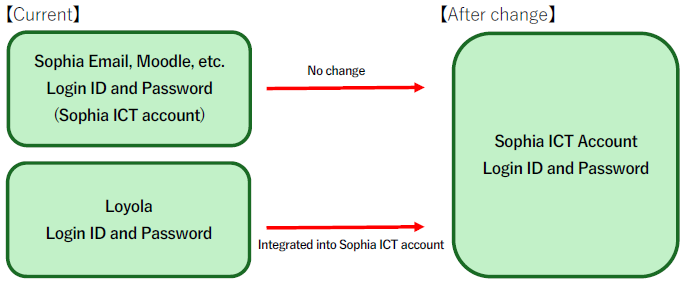
| Systems | How to log in |
|---|---|
| Loyola Moodle Sophia Mail CaLabo MX Self-learning Portfolio My OPAC Mailing List |
From individual login for each system, they will be integrated authentication system login, using the ID and password of the Sophia ICT account. From now on, SSO will eliminate the need to log in again unless closing the browser after logging in once. |
| COM classroom PC VPN sophiawifi2019, etc. |
Log in to each systems using Sophia ICT Account ID/password. |
| Zoom (until January, 2025) | Log in using the account which you signed up. |
Change or Reissue of Password
Currently, Loyola passwords can be reissued at the Loyola login screen, or the Center for Academic Affairs is handling the reissuing Loyola passwords. However, after introducing the Integrated Authentication System, Loyola passwords will be discontinued and only Sophia ICT accounts will be used so that the ICT Office will reissue passwords. If you lose your password after September 7,2024, please come to ICT Office with your student card.
Password Reminder Registration Request
By registering for a password reminder in Sophia Integrated Database System, you can reissue a password without coming to the ICT Office. If you have not yet registered for a password reminder, please do so. For details on how to register, please refer to the following URL.
https://ccweb.cc.sophia.ac.jp/en/userguide/password/pass-04-en/
Reissue of Password
ICT Office web site: https://ccweb.cc.sophia.ac.jp/userguide/password/pass-03-en/
If you have any questions, please contact the ICT Office.
Mail:ict-support@sophia.ac.jp
Changes to the login/logout screens following the launch of the Integrated Authentication
The following are the screen changes associated with the start of the Integrated Authentication System. (e.g. Moodle)
| Before | After | |
|---|---|---|
|
[1]
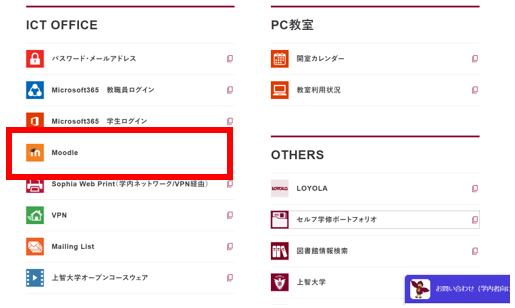 Click on the “Moodle” icon on the ICT Office website. *You can also access it from your favorites and bookmarks. |
||
[2]  Moodle login screen will appear. User Name: Student Number Password: Same as Sophia ICT account |
[2] Integrated Authentication System login screen will appear. User Name: Student Number Password: Same as Sophia ICT account *If your browser’s display language is “English, the site will automatically be displayed in English. |
|
|
[3]
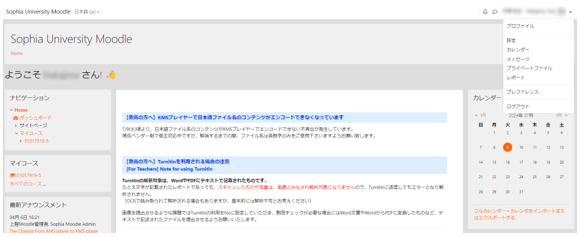 You can log in to Moodle. |
||
|
[4]
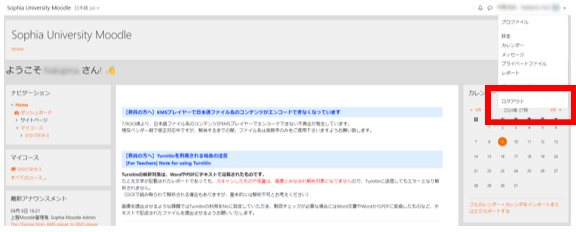 Log out of Moodle. |
||
[5] It will return to Moodle login screen. |
[5] Since SSO is still enabled, you can click on other icons to access the system without entering your ID and password. Since SSO is still enabled, you can click on other icons to access the system without entering your ID and password.In addition, if you click on icons, systems without an account cannot be accessed as before. |
|
[6]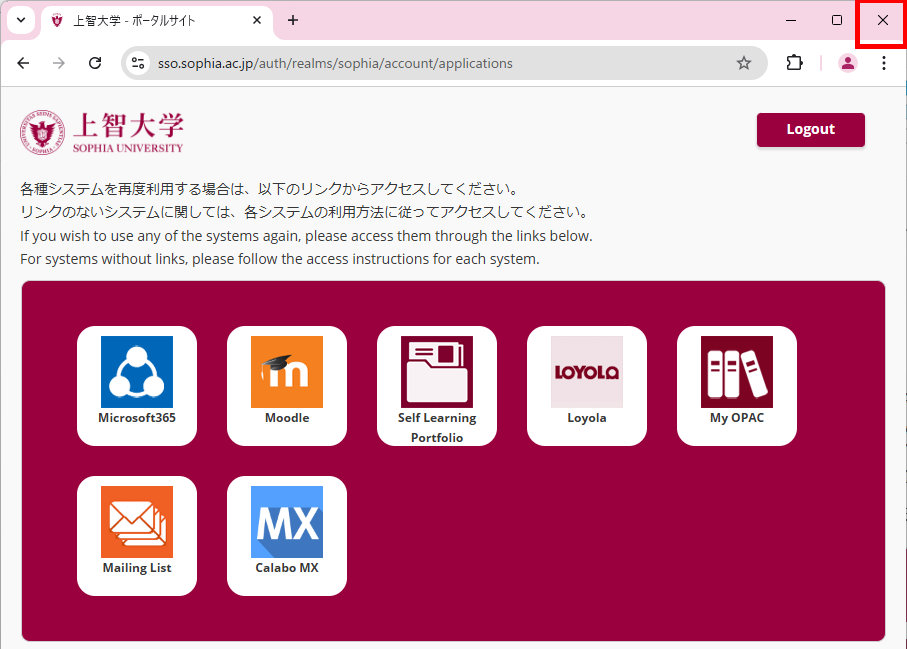 If you close the browser with “x”, the SSO authentication will also be disconnected, so you must go through the process [1] -> [2] again. Usually, you don’t need to click on “Logout” in the upper right of the screen. |
||
 ICT Office
ICT Office